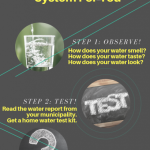Water filters are some of the essential systems you can have in your home. Although you may live in a place with sufficient and clean water, sometimes you need to filter the water further. There are different ways a water filtration system can help you at home.
Sometimes you may need to get rid of some minerals in the water. Or, the water you are using may have some odor or bad tastes that you do not want. The best thing to do here is using a water filter to purify it.
It is crucial to understand how water filters work before you can install one at your home. Also, you should find the right filter by following guides such as https://worldofwaterfilter.com/best-under-sink-water-filter-guide/ .
In this article, we look into various ways water filters work to improve the quality of water we use:
Distillation
Distillation works easily. The system heats the water to the boiling point. As you know, at this point, water will turn into vapor and escape to the environment. This vapor gets channeled to a condenser where it condenses and gets collected in a second container.
Most chemicals take long to boil and evaporate. That means you will manage to collect almost all the water before they start vanishing. However, this method is not always effective. Some chemicals boil faster than water, and if they do, they will also get collected in the second container.
Reverse Osmosis
It is a more complicated water filtration method that is more effective than most of the ways other filters work. In this case, 5 different filters work to ensure the water gets filtered. Each filter serves a unique purpose, and they collectively manage to filter the water.
First, it begins with the filter that blocks big particles that may destroy other parts of the system if they get let in. These particles may include dust, rust, or even debris that may cause the system to stall if allowed to get into it.
Next, the system starts to get rid of chemicals in the water. It happens at the second filter and marks that the second stage of the filtration process. Here chemicals such as fluoride and chlorine get filtered, and the water moves on to the next step.
The next step is essential because it seeks to leave the water almost contaminant free. Here, the following filter is responsible for ensuring carbon does not remain in the water. The filter is denser to ensure that even the smallest particles do not go through it.
Next and most essential is the reverse membrane. It serves a unique purpose in the system. It determines the size, weight, and molecular charge of particles before blocking them. Here, there is no particle that can get past so long as it is not water enriching mineral.
The fifth filter is a special one that sometimes includes a UV system that increases the water PH. Also, any amount of chlorine that penetrated past the fourth filter remains at this point, and all bacteria get killed at this point, making the water very clean for human consumption.
Activated Carbon
It is a charcoal filter that works through absorption. There is a carbon filter that gases have to pass through, and when they do, any unwanted gases or liquids get absorbed into the carbon. It is an effective process that has proven to work in making water clean for human use.
One of the downsides of using this type of filtration is that not all impurities will get attracted to the carbon filter. Therefore, it can only work for most contaminants, while others like limescale still pass through the filter.
Also, it can sometimes require maintenance because the filter can clog up after a period of use. Therefore, it will not work well in removing contaminants, and thus, you may be consuming dirty water if you do not act quickly.
Ion Exchange
Ion exchange filters also work effectively to filter water. They contain zeolite beads that have sodium ions that facilitate the filtration process. It works in a more sophisticated manner, because the hard water that goes through contains magnesium and calcium components.
These two components attract the ions and release sodium in exchange. However, this water will be salty because of the sodium that goes through it.
The rest of other components such as calcium and magnesium, will remain at the filter hence making the water softer. The remaining water may not be ideal for everyone because of the saltiness, especially those who are on a strict diet.
Water Systems
It is possible to install a whole water system to ensure your water is clean and safe for everyday use. For example, Leaf Home’s whole home water system offers complete whole-home filtration, UV disinfection, and drinking water thanks to reverse osmosis. It uses similar techniques to what we have discussed already, but applies it to every faucet in your home.
This means you can get fresh and clean-tasting water no matter where you are in the house, whether you are in the kitchen, bathroom, or laundry room. This comprehensive system ensures that every drop of water you use is purified, enhancing your overall health and well-being.
Conclusion
Water filtration can take different ways, especially on how filters work. Therefore, when looking for the right solution to your water, especially after reading the water report, always consider how a filtration method works and compare it with others. Clean water is essential for drinking and house chores.








Pingback: Steps To Take When You Have A Leak In The Home | My Beautiful Adventures